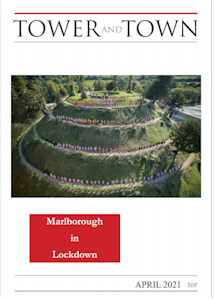

Tower and Town, April 2021 (view the full edition) (view the full edition)Sevenoaks Or Savernake?The old Saxon name for our local forest was Saofernoc which does actually mean ‘seven oaks’. Perhaps there were seven significant oaks or oak copses, but a quaint coincidence is that the current Ordnance Survey map shows seven oaks! But enough of circumspection. Savernake, over its known 1100 years' history has seen many changes in both size and management. Seized from the Saxons by the Normans in 1067, it covered an area south of the Kennet from Manton to Chisbury, Burbage and Wootton Rivers and became a private estate of King William (the Conqueror). William then gave hereditary wardenship to his faithful knight Richard Esturmy whose duty was to provide the king with 'verne and verdure', which is understood to imply meat and timber. As meat implied hunting, an extensive dense woodland with heavy undergrowth as nowadays was of no use; the forest would have been an area of several small copses of specially grown trees scattered on open heathland. The word 'forest' therefore did not mean a large wood. It referred to areas set apart from the common land (where commoners lived) and owned by the king, and in which his rather harsh 'forest law' applied as opposed to 'common law' in the rest of the country. Savernake obviously flourished, as Henry II saw fit to steal land from his vassals and add it to his forest. It thus expanded to East Kennet, Inkpen, Ramsbury and Collingbourne Kingston making an estate of 150 square miles. There was great complaint throughout Henry II's reign as well as his sons' Richard I and John. The Magna Carta required the old boundaries to be re-established but as John especially enjoyed the hunting and his successors weren't interested in justice, it wasn't until Edward III that action was taken. A commission of gentlemen rode and redefined the 'remembered' boundary with the oddity of a significant wedge of land that penetrated to the very middle of the current forest being allocated to another owner. One wonders about exchanges of money bags or threats! From lack of an Esturmy male heir, the wardenship passed by marriage to the Seymour family and it was Jane Seymour's son the young King Edward VI who rewarded his guardian and uncle, Edward Seymour, by giving him the estate. Savernake at some ten times its current size remained largely unchanged in area until the 20th century when much was sold leaving just the wooded area we now know and passing by marriage to the Bruce and then the Brudenell families. It was Mr Lancelot 'Capability' Brown who, in the 1790s, designed much of the current forest layout with the beech-lined Grand Avenue and the 90 foot column and its Ride. He also designed Eight Walks as a visual maze that still catches out people relying on the OS map which doesn't differentiate between the eight radiating tracks. Though Savernake changed much, the same family was custodian for well over 900 years but through necessity, ownership is now shared with the land consultants Strutt and Parker. There is however nothing in the forest to mark its history, and so, with the approval of David Brudenell-Bruce (Lord Cardigan), four ancient oaks will shortly bear the family names: Esturmy, Seymour, Brudenell and Bruce. War-time Savernake is another story. Peter Noble |